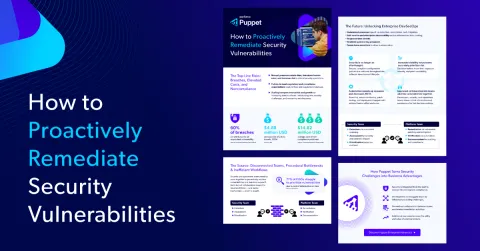Blog
May 12, 2025
Securing the Software Supply Chain: Why It’s More Important than Ever
Infrastructure Automation,
Security & Compliance
The software supply chain has become the backbone of modern IT environments. It powers applications, underpins operational processes, and drives innovation within organizations across industries. Securing the software supply chain has moved from a peripheral concern to a central element of cybersecurity: The vast network of code, dependencies, integrations, and third-party tools that comprise the supply chain is increasingly under siege from cyber threats and at risk of exploitation.
High-profile supply chain attacks like SolarWinds and Log4j have shone a spotlight on the devastating consequences of security lapses. Meanwhile, governments and regulatory bodies are introducing tighter frameworks and requirements to ensure organizations safeguard their operations. This blog explores the critical importance of securing the software supply chain and how organizations can address evolving challenges as part of their cybersecurity strategies.
What is Software Supply Chain Security?
Software supply chain security refers to the practice of protecting every component, process, and entity involved in developing, delivering, and maintaining software — both in the tools you use and the software those tools depend on. This includes securing third-party code, open source libraries, tools, and development environments that contribute to the software lifecycle.
All it takes is an unpatched CVE in one third-party library to expose your critical systems to attack, breach, invasion, and compromise. Securing the software supply chain means ensuring the software you use (and any dependencies those tools have) are patched, up-to-date, protected against vulnerabilities, and compliant with regulatory and business expectations.
Back to topWhy is Securing the Software Supply Chain Critical?
The growing reliance on complex supply chains opens the door to unique security vulnerabilities. A single compromised component can cascade through an organization, potentially affecting thousands of connected systems and users.
The Threats Lurking in the Supply Chain
The data makes it clear: Modern digital infrastructure is highly dependent on open source software (OSS). A remarkable 96% of organizations use at least some open source software, and a 2025 study by Black Duck found open source code in 97% of codebases. OSS is usually low-cost (or free) and community supported, making it a popular ingredient in the commercial software that ends up in your supply chain (or even in your own stack).
The problem is that OSS that lacks vendor backing, for all its flexibility and community support, is ripe for vulnerabilities. A study published in 2025 found an average of 68 vulnerabilities in OSS packages, including an average of six rated “critical severity” and 33 rated “high severity.”
Free and open source software (FOSS) can be an engine for innovation, but its lack of formal backing by trusted vendors means it’s not always held to the same expectation of security as commercial options — and that can leave your software supply chain open to attack and exploit.
Several high-profile attacks underline the consequences of inadequate software supply chain security:
- SolarWinds (2020): This far-reaching breach impacted over 18,000 organizations, including government agencies and Fortune 500 firms, due to a compromise in a software update.
- Log4j Vulnerability (2021): This exploit highlighted how a widely used open-source library could be weaponized, affecting applications globally and requiring swift patching.
- xz Backdoor (2024): This backdoor leveraged a vulnerability in XZ Utils, a popular open source compression tool, to enable unauthorized users to remotely access and manipulate systems that used it.
- 3CX Supply Chain Attack (2023): The compromise of the widely used VoIP provider led to the exposure of sensitive business communications and user data.
These incidents emphasize the critical need for organizations to take a proactive stance in managing their software supply chain’s security.
Evolving Regulatory Compliance
Governments and regulatory bodies have responded to this growing threat landscape by introducing stricter frameworks, explicitly calling for enhanced supply chain security. In the US, 2021’s Executive Order 14028: “Improving the Nation's Cybersecurity” placed a special emphasis on supply chain security, directing the National Institute of Standards and Technology (NIST) to develop guidelines specifically for securing the software supply chain.
In the US and around the world, supply chain security in software has become an area of focus for many regulations and frameworks. Here are a few examples:
- NIST Cybersecurity Framework: Updated as of 2023, this framework specifies securing supply chain dependencies as a core pillar of risk management.
- ISO 27001 Standards: These international standards for information security include supply chain security as a critical compliance requirement.
- NIS2 Directive: When the EU adopted the second version of the Network and Information Security Directive (NIS2), several updates expanded its reach to cover the IT supply chain, including more industries as well as newly covered digital service providers.
- CISA Directives: Multiple advisories from the Cybersecurity and Infrastructure Security Agency (CISA) stress the role of supply chain protection in safeguarding critical infrastructure.
Failure to adapt to these compliance obligations risks not only regulatory penalties but also reputational damage and operational disruptions.
Back to topTips to Secure Your Software Supply Chain
Like all good cybersecurity, protecting your organization, revenue, and reputation from supply chain vulnerabilities requires a proactive approach. That includes your choice of software vendors, how you enforce secure versions, how you address vulnerabilities when they’re identified, and how you maintain and prove compliance with security policies (both internal and external).
Here are the top ways organizations can protect their critical systems from vulnerabilities in their software supply chain:
Start with Secure Builds and Trusted Sources
Securing your software supply chain begins with building from trusted, secure sources. Ensuring that the components you integrate are vetted and originate from reliable vendors can reduce the risk of introducing vulnerabilities. Additionally, prioritize partnerships with suppliers that provide ongoing updates and strong support, which helps address threats as they evolve.
Making secure sourcing a priority establishes a solid foundation for your systems and safeguards against downstream risks tied to third-party integrations or untrusted dependencies.
Enforce Approved Software Versions 24/7
Unverified or outdated software versions can be a gateway for attackers. By enforcing the use of approved, vetted software versions across your environments, you minimize the chance of deploying compromised components. Use tools that centralize policy management to ensure all deployed software aligns with organizational standards. This not only reduces security risks but also helps maintain consistency and reliability across systems.
For example, before rolling out updates, your team can rely on automated systems to verify that all configurations meet pre-established criteria, ensuring nothing unauthorized slips through the cracks.
Automate Patching and Vulnerability Remediation
When vulnerabilities emerge, speedy remediation is essential. Automating patch management enables your organization to quickly address security flaws, reducing the time your systems remain exposed to threats. High-profile incidents like the Log4j vulnerability highlight how automation can drastically shrink your attack surface and prevent exploitation.
By investing in automation, you can accelerate remediation efforts, ensure critical updates are applied without unnecessary delays, and free up your IT team to focus on more strategic initiatives.
Streamline Compliance Reporting
Maintaining compliance with regulatory requirements often means generating detailed reports to prove your adherence to security policies. Automating compliance documentation can save time and reduce errors, making it easier to produce audit-ready reports. Solutions that consolidate data from across your systems allow you to quickly generate clear, comprehensive records for internal reviews or external audits.
This streamlined approach benefits industries with stringent compliance demands, such as healthcare or finance, by cutting the time spent preparing for audits while improving overall reporting accuracy.
Back to topHow Puppet Helps Secure You Against Supply Chain Vulnerabilities
The risks of leaving your software supply chain unprotected are already too great to ignore, and the software supply chain will only grow more complex as organizations increasingly rely on third-party libraries, APIs, and integrations. This complexity will invite new types of attacks, forcing IT leaders to adopt adaptive and proactive security measures.
Proactive organizations will rely on automated, scalable solutions to maintain vigilance over their supply chains. The Puppet Enterprise platform enables enterprise IT Ops, Security, and Compliance teams to face new and emerging software supply chain threats.
Hardened Releases & Vendor Backing
By securing your software’s foundation and offering ongoing vendor assurance, Puppet reduces risks associated with third-party integrations and untrusted sources. Puppet Core and the Puppet Enterprise platform are supported with frequent releases, rigorous testing, proactive security updates, certified builds, and signed binaries and agents — all backed by Perforce Software.
The support of an established, reliable software vendor means you can confidently meet SLAs, maintain trust with your customers, and keep critical infrastructure components secure.

Streamlined Patching & Vulnerability Remediation
Vulnerability Remediation in the Puppet Enterprise platform streamlines vulnerability management workflows like patching, so you can maintain a higher degree of security while minimizing toil and downtime:
- Integrate with popular security scanners to ingest vulnerability data right into the Puppet dashboard
- Visualize, filter, and sort CVEs by severity to enable collaboration between Security and Operations
- Reduce mean time to remediate (MTTR) and eliminate manual error by automating remediation workflows
- Customize patch node groups for fine-grained control over patching processes
- Document remediation efforts automatically for compliance reporting
24/7 Configuration and Security Compliance Enforcement
Puppet makes sure that only approved, vetted software versions are deployed across your environments. With declarative, agent-based automation and policy as code, Puppet enforces your desired infrastructure state 48 times per day (17,520 times per year) to ensure strict compliance with organizational software policies, reducing the risk of deploying compromised components. Puppet will automatically verify that all configurations meet the pre-approved standards before deploying any changes.
Automated Documentation & Smooth Compliance Reporting
Meeting regulatory requirements often involves generating detailed, audit-ready reports that demonstrate compliance. Puppet simplifies this labor-intensive task with automated documentation of every configuration change, helping teams create clear, comprehensive reports that satisfy auditors with less manual effort.
Robust automation helps you manage and maintain resilient infrastructure, even as your systems grow in size and complexity. Request a demo of the Puppet Enterprise platform today, or learn more about how automation helps you stay ready for threats and new regulations with our white paper.
Request a Demo Download “How Automation Helps You Stay Compliant”

